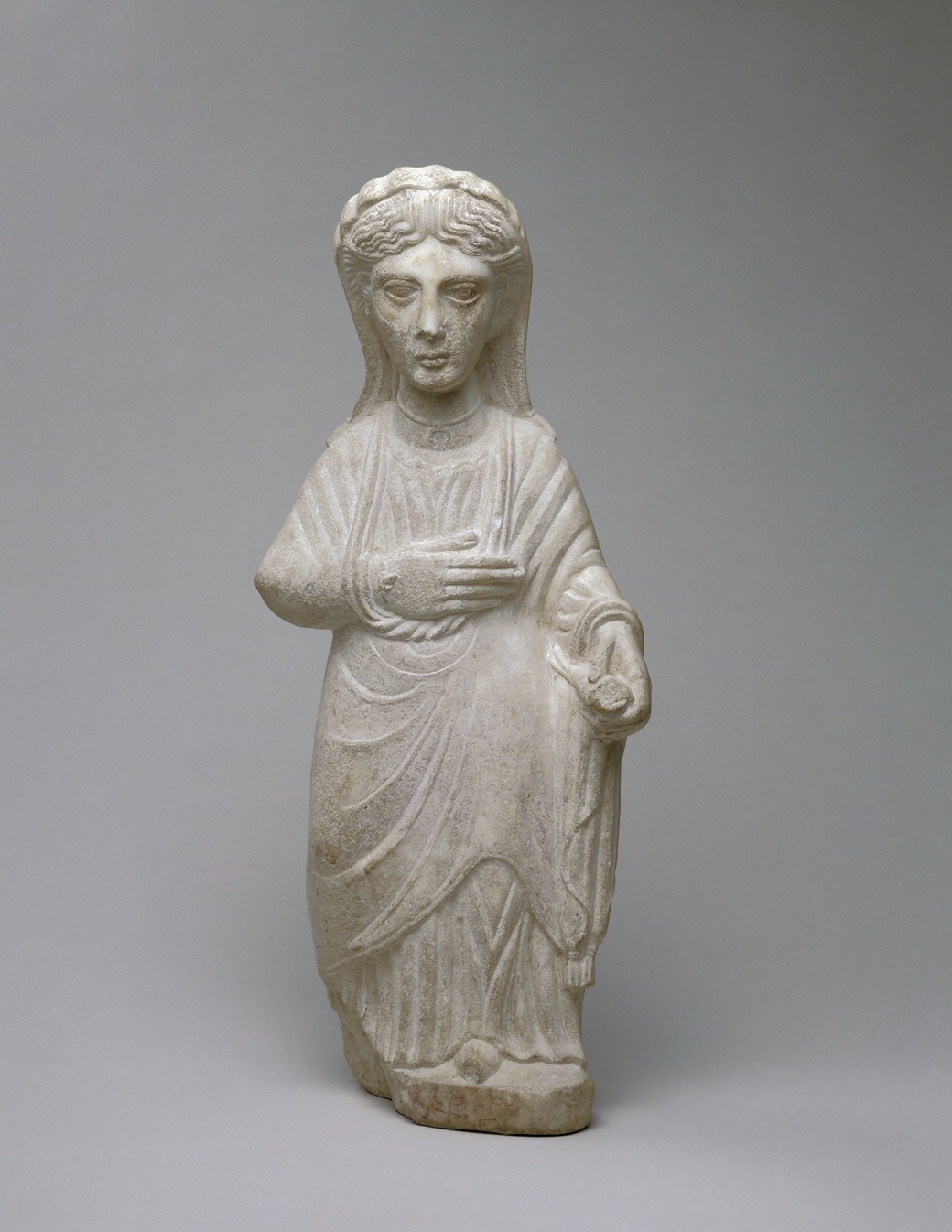
Marble
H: 54 cm
Provenance: no indication
Phrygian
Late 2nd-early 3rd century A.D.
Sculpted in an originally crystalline white marble, detailed in front, the back treated summarily. Parts such as the face highly polished. An inscription chiselled on the front of the base.
Condition: her tunic and mantle with traces of pink colour in front and wine-red at the back; other parts possibly once painted but no traces now visible. Missing: the head and neck of the dove, a piece of the front side of the base with part of the inscription and a small section of her tunic, also a sliver from the back right side of the base; the tip of her nose chipped, a nick to the front of her veil, a chip on the fold of mantle near her right thumb, the end of her left slipper broken away. Much of the frontal surface covered by a creamy limestone incrustation. The original surface, where visible, now slightly ivory-coloured.
This charming girl, a torque around her neck with crescent- shaped pendant, stands on a plinth. She is dressed in a long chiton, over it a mantle with two tassels, her head covered with a veil - a tassel at either end - which falls over the back of her shoulders. Her right hand is held over her breast and in her left she is holding a dove.
On the plinth are the remains of an inscription with the last two letters of a name followed by the word "Theo" (to God) and with letters that may mean "as vow". Thus the inscription should read:
(personal name)
(cult name of god)
Since the inscription indicates that she is a vow, she must have been "dedicated to a god presumably in his temple or sanctuary. It might seem surprising that a masculine god should receive the statue of a girl, but I don't think it is a difficulty. Possibly the dedicator wished to dedicate the statue of someone close to him, say, a child who had been saved from danger, though if that was so I would have expected him to say so. More likely, this was a cherished work of art which he wished to give to the god as a gift" [1].
She is rather exceptional in that she is carved and modelled with an unusual sensitivity, and though a free-standing statue relates stylistically to a very large number of distinctive grave stelai that were manufactured in Phrygia from the mid 2nd century until the beginning of the 4th century A.D., probably in or near the city of Soa in the upper Tembris valley [2]. The author visiting the Archaeological Museum in Istanbul a few years ago and looking for a comparison, noted the closest parallel to be one of these stelai bearing at the time the inventory no. M 73.64.
They usually depict a male and female - sometimes accompanied by children - standing in a rigid frontal view though on some stelai there is only a single figure. They are dressed in similar fashion to this statue, note especially the way the mantle is draped around the right arm with the right hand protruding out from under it; the left usually holds an object at the side - the women a spindle and young girls as here a bird. They all strike a similar pose. Note the way the folds of the drapery hang over her chiton forming an arch over the left knee. This is the same on the stelai, and when not holding an object their left hands are flat over the arch and slightly to the side.
All these stelai are rather provincial carvings, usually in fairly flat relief, though some are in high relief, and one in Malibu almost in the round [3]. They are all of mediocre quality.
1 Thanks to David Mitten the author consulted Christopher P. Jones to whom we are grateful for having written regarding the inscription, stating that the statue is "surely not a funerary monument" as we had qualified her mistakenly in the previous editions of this catalogue.
2 Koch, G.: Zwei Grabreliefs aus Phrygien im J. Paul Getty Museum. Roman Funerary Monuments in the J. Paul Getty Museum, Volume 1, Occasional Papers on Antiquities, 6 (Malibu, 1990), pp. 115-132.
3 J. Paul Getty Museum 77.AA.32: Koch, G.: op. cit.., ill. 12.